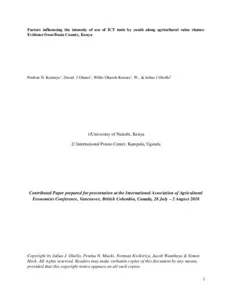Factors influencing the intensity of use of ICT tools by youth along agricultural value chains: Evidence from Busia County, Kenya.

Abstract
Focus on youth has considerably increased throughout the developed and developing countries, especially within Sub-Saharan Africa (SSA) in recent times. Youth are generally considered as key drivers to development of an economy although they face challenges of unemployment. The Information and Communication Technology (ICT) sector is one of the rapidly developing sectors in the developing world, with the young generation being presently engaged in use of new technologies. Information and communication technologies are beneficial in many sectors including agriculture, but there is less evidence of its use for agricultural purposes particularly by the youth. The desire to change the face of agriculture for youth to find it appealing has seen the need to assess the relevance of youth participation in agriculture and the integration of ICTs into the agricultural sector as a solution to youth migration and unemployment. This study analyzed the determinants of ICT usage in agricultural value chains among rural youth in Busia County, Kenya. A total of 213 young farmers were randomly selected and interviewed using semi-structured questionnaires. Descriptive statistics and Poisson regression model were applied in data analysis. Findings showed that; most youth are concentrated in the cereals, horticulture and livestock value chains. Youth’s participation using ICTs was mainly concentrated at the marketing level of the agricultural chain activities. Age, marital status, transport cost, distance to market, number of agricultural value chains, land size and access to extension services were found to be significant in explaining the intensity of use of ICTs for agricultural purposes. Interventions should be designed to focus on innovative technologies that are youth-friendly to enable youth effectively integrate ICTs in agricultural value chains.
